When will the EPD have "saturation" problems?
Updated on Thu, 2018-01-18 12:39. Originally created by lisa on 2018-01-17 14:10.
Introduction
The STAR Event Plane Detector is composed of 744 individual scintillator tiles in two 90-cm-radius wheels (one each on East and West side) at z=+/- 375 cm from the center of the TPC. For collisions at (0,0,0), it covers pseudorapidity 2.1<|eta|<5.1. One-eighth of the detector (a quarter wheel on the East side) was installed and commissioned in run 2017, and the full device will be completely installed for run 2018. After one day of commissioning with beam (concurrent with other detectors getting up and running), it will be ready for physics.
The EPD's main purpose is to provide a TPC-independent centrality measure and the event plane at forward rapidity.
As discussed in the construction proposal (SN0666) the segmentation of the Event Plane Detector was optimized for BES energies. There, it was envisioned mostly as a hit/no-hit detector, and the goal was to keep double-hits below 10%.
However, with careful construction, the energy loss resolution is good enough (and well-understood enough) to probabilistically distinguish multi MIP events. Below are the ADC spectra for two tiles, measured in Au+Au collisions at 54 GeV in the 2017 run. The shaded regions show contribution from N-MIP events, according to Landau distributions. The only fit parameter is the position of the 1-MIP peak. The widths and positions of all other peaks are not fit parameters, but fixed by the 1-MIP peak. (Obviously the height of the distribution is also a fit parameter, because the physics of the collision determines that!) Poisson statistics are not included because <Nphoton>/MIP~45 is large enough so that Landau fluctuations dominate.
As mentioned, the N-MIP contributions overlap, so we have a probabilistic convolution of 1-,2-,N-MIP events. This is mandated by energy-loss physics. Full separation would require much thicker scintillator plastic. The curves below are as good as can be achieved. They are similar to the ADC distributions from the inner BBC tiles, which is unsurprising since the BBC is made of essentially the same scintillator and thickness. Hence, the EPD may be thought of as a much more finely-segmented and much larger version of the inner BBC.
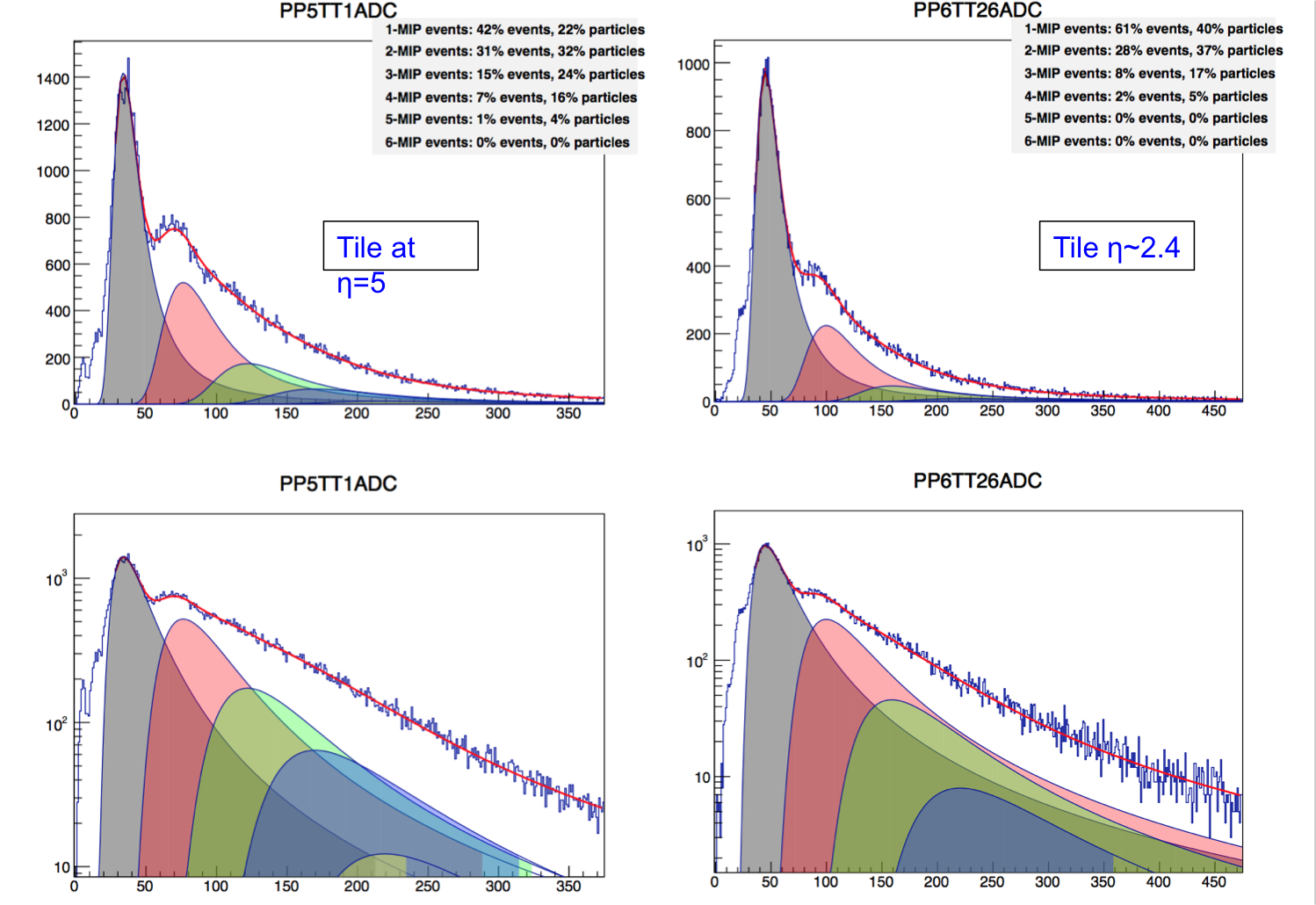
The ADC distribution for two tiles from the Au+Au 54 GeV run in 2017. Upper and lower panels are linear and log scales, respectively. Shaded regions show contributions from 1-,2-,3-,4-MIP events. The red curve shows the sum of all contributions. This is from minimum-bias collisions. The "percent of events" found in the legends neglect the #MIP=0 events, so are not strictly correct.
The excellent agreement between the Landau distributions indicates that the ADC value is proportional to the energy lost in the tile.
This well-understood performance means that the EPD functions well even at energies much higher than those in BES. More details may be found in Mike's presentation at the November 2017 Analysis Meeting.
"Saturation"
But how much flux would be "too high?" I.e. when will the output signal no longer be proportional to the energy loss? As we face the 2018 run, this question is relevant for the 200 GeV Zr and Ru beams. (Since the device handles the 54 GeV Au+Au system well, it will handle 27 GeV Au+Au in 2018 with no problem.)
Saturation/nonlinearity can arise if
The curves above used the old FEE cards; the newer ones have higher gain. With the new FEE cards, the single-MIP peak sits at about 150 ADC counts, and the 4-MIP peak around 700 counts (more than 4*150=600 due to convolution of Landaus with tails). Landau distributions of course go "forever," but the 4-MIP distribution is down by about two orders of magnitude when ADC=4096. From this point of view, then, we expect no saturation up to 4-MIP events. When 5 or more MIPs pass through a tile, we'll start to have some nonlinearity. (Precise statements require simulation, which is led by Prashanth Shanmuganathan and is underway.)
Looking at #4:
The light from the scintillator is directed through fibers onto a multipixel silicon photomultiplier (SiPM). Our SiPMs have 25-micron pitch, and our clear fiber bundles have 1.15-mm diameter, meaning that 1662 of the 2668 pixels on the device are illuminated. A pixel generates a photoelectron (with some quantum efficiency) when struck by a photon from the fiber. If another photon hits the same pixel, you don't get another photoelectron. This would be a "saturation" effect.
As a rough guide, if more than 25% of the pixels (~415) fire, then there will be some saturation (I could do a calculation to be more precise, and I have it somewhere...), as the number of photoelectrons produced is no longer proportional to the intensity of light incident on the SiPM.
For one MIP through a tile, we get about 40 photoelectrons as a most probable value (MPV). The tail of the 3-MIP signal peters out around 10 times this value, so there should be no saturation for up to 3-MIP events. For 4-MIP events, there can be saturation in the tail. That said, we see no evidence of non-linearity for up to N=4 MIPs in the 54 GeV data, so as a working statement, I feel safe saying that for N<5 particles passing through a tile, saturation will not be a significant effect.
So the question becomes....
How often will more than 4 particles pass through a tile?
This depends on
First, we look at 19.6 GeV Au+Au collisions. The probability of a multi-hit event is less than ~10%, by design at this energy. In fact, the probability distribution is essentially the same for all tiles. The EPD was designed for this energy
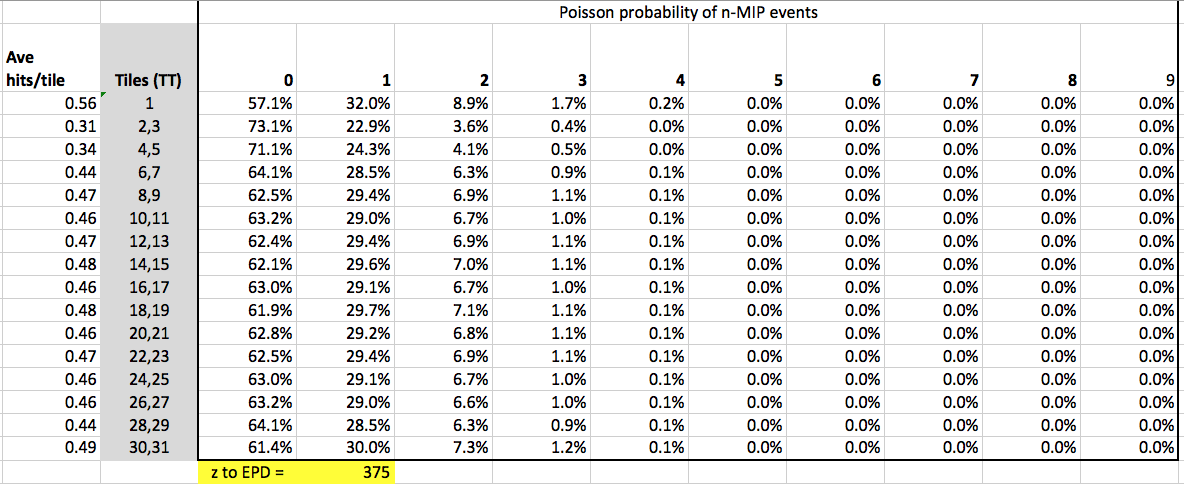
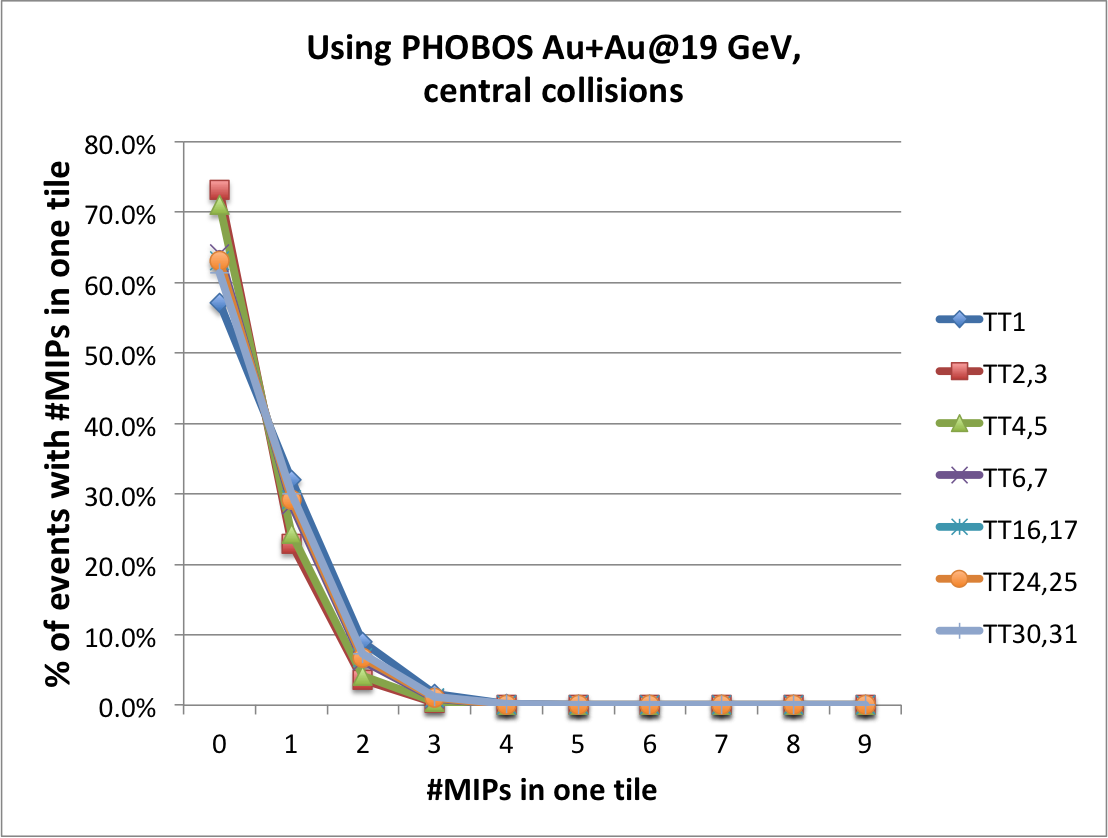
Now 62 GeV Au+Au collisions (already discussed here). Tile 1 (highest eta, and only 12 tiles in azimuth) gets the most flux, as expected. Interestingly, tiles 6,7 get more than their neighbors. This is just dictated by the shape of dN/deta and the tile sizes. The number of 5+ events is very small.

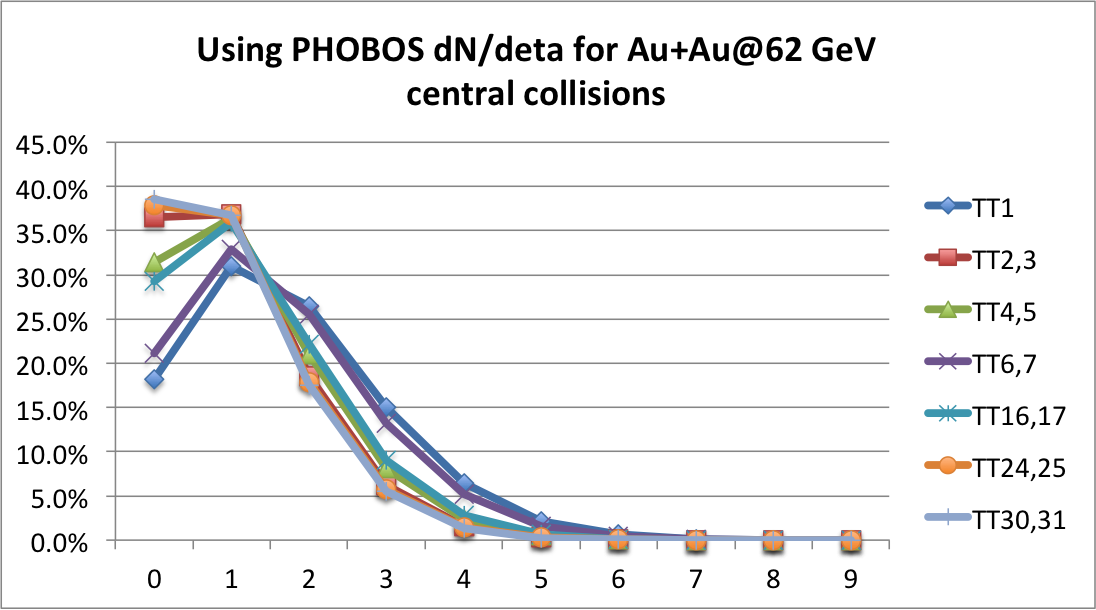
Now 200 GeV Au+Au collisions. Whoah! We'd hit trouble there! Tile 1 is dominated by 5+ MIP events, so will definitely saturate. Only the outer-most tiles (tiles 20 and above, which are 2.1|eta|<2.6) will have little saturation.

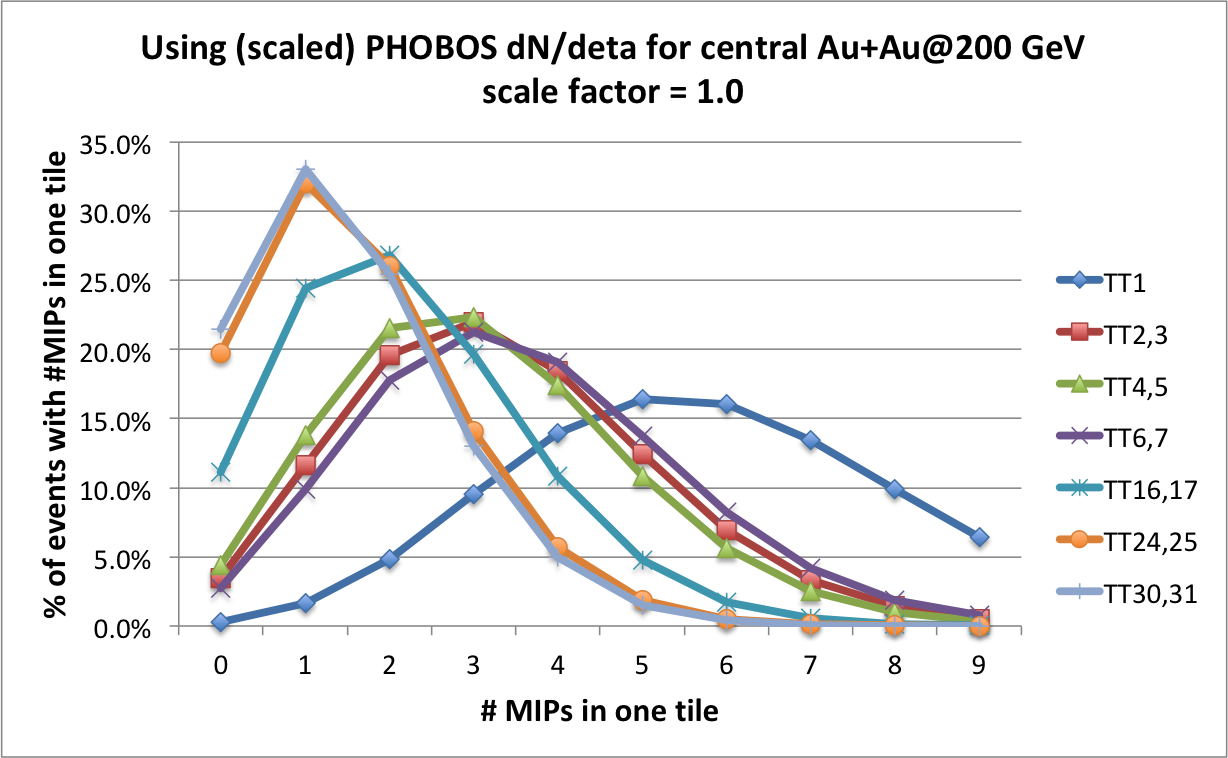
For Zr and Ru at 200 GeV, we have no measurements of dN/deta, but it should go as Npart, so I simply take dN/deta for Au+Au central collisions at 200, scaled down by a factor of 2. Tile 1 (innermost tile, 4.5<|eta|<5.1) will have 5 or more MIPs 17% of the time for the most central collisions. The other tiles should be fine.

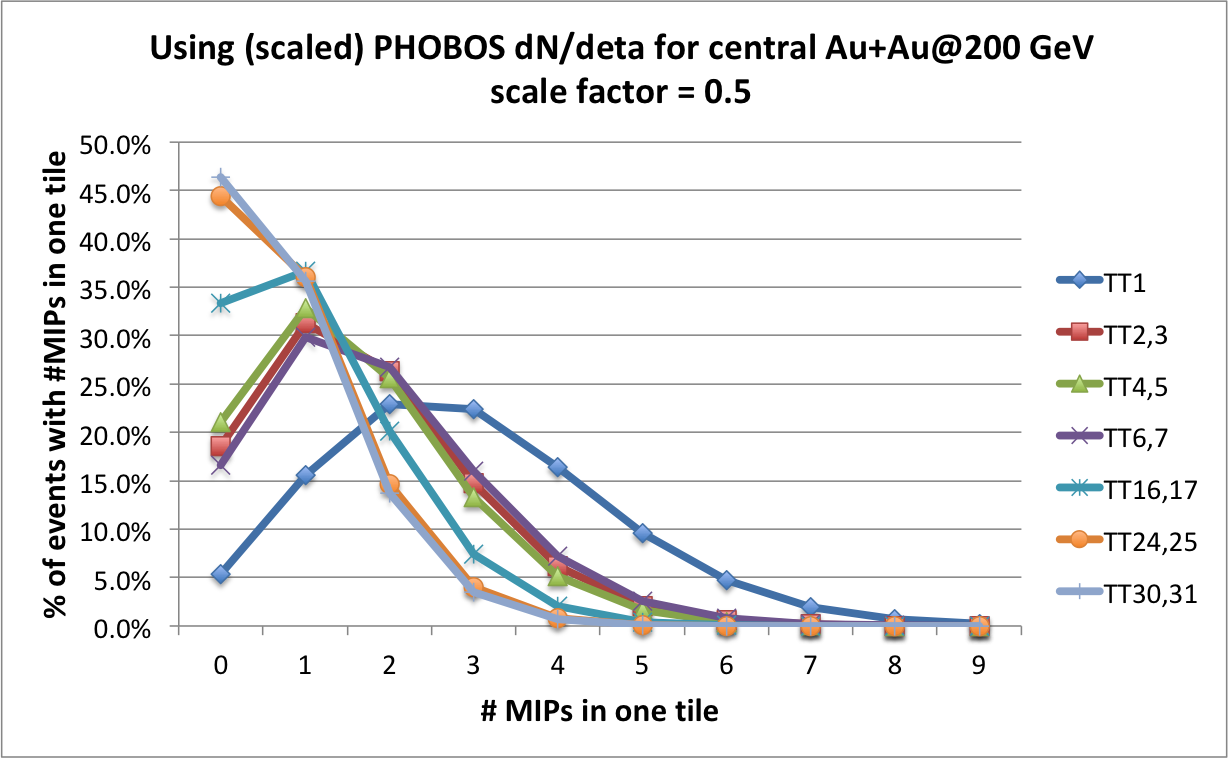
My conclusions:
Caveats: This study does not include contributions from scattering off of the beam-pipe. Prashanth is working on simulations of that. Nevertheless, the 5-hit fraction for Zr/Ru+Zr/Ru collisions at 200 GeV is very similar (1-2%) as for 62 (~54) GeV Au+Au collisions. Since the 54 GeV data from 2017 looks good, the 2018 isotope data should look fine as well.
The STAR Event Plane Detector is composed of 744 individual scintillator tiles in two 90-cm-radius wheels (one each on East and West side) at z=+/- 375 cm from the center of the TPC. For collisions at (0,0,0), it covers pseudorapidity 2.1<|eta|<5.1. One-eighth of the detector (a quarter wheel on the East side) was installed and commissioned in run 2017, and the full device will be completely installed for run 2018. After one day of commissioning with beam (concurrent with other detectors getting up and running), it will be ready for physics.
The EPD's main purpose is to provide a TPC-independent centrality measure and the event plane at forward rapidity.
As discussed in the construction proposal (SN0666) the segmentation of the Event Plane Detector was optimized for BES energies. There, it was envisioned mostly as a hit/no-hit detector, and the goal was to keep double-hits below 10%.
However, with careful construction, the energy loss resolution is good enough (and well-understood enough) to probabilistically distinguish multi MIP events. Below are the ADC spectra for two tiles, measured in Au+Au collisions at 54 GeV in the 2017 run. The shaded regions show contribution from N-MIP events, according to Landau distributions. The only fit parameter is the position of the 1-MIP peak. The widths and positions of all other peaks are not fit parameters, but fixed by the 1-MIP peak. (Obviously the height of the distribution is also a fit parameter, because the physics of the collision determines that!) Poisson statistics are not included because <Nphoton>/MIP~45 is large enough so that Landau fluctuations dominate.
As mentioned, the N-MIP contributions overlap, so we have a probabilistic convolution of 1-,2-,N-MIP events. This is mandated by energy-loss physics. Full separation would require much thicker scintillator plastic. The curves below are as good as can be achieved. They are similar to the ADC distributions from the inner BBC tiles, which is unsurprising since the BBC is made of essentially the same scintillator and thickness. Hence, the EPD may be thought of as a much more finely-segmented and much larger version of the inner BBC.

The ADC distribution for two tiles from the Au+Au 54 GeV run in 2017. Upper and lower panels are linear and log scales, respectively. Shaded regions show contributions from 1-,2-,3-,4-MIP events. The red curve shows the sum of all contributions. This is from minimum-bias collisions. The "percent of events" found in the legends neglect the #MIP=0 events, so are not strictly correct.
The excellent agreement between the Landau distributions indicates that the ADC value is proportional to the energy lost in the tile.
This well-understood performance means that the EPD functions well even at energies much higher than those in BES. More details may be found in Mike's presentation at the November 2017 Analysis Meeting.
"Saturation"
But how much flux would be "too high?" I.e. when will the output signal no longer be proportional to the energy loss? As we face the 2018 run, this question is relevant for the 200 GeV Zr and Ru beams. (Since the device handles the 54 GeV Au+Au system well, it will handle 27 GeV Au+Au in 2018 with no problem.)
Saturation/nonlinearity can arise if
- the voltage signal from the FEE card gets nonlinear for large signals - this should not be a problem according to bench measurements
- the ADC gets nonlinear for large signals - the QT has been measured to have good linearity through its entire range
- the input to the 12-bit ADC corresponds to a number larger than max value of 4096
- the number of photons incident on the SiPM is more than (say) 25% of the number of pixels illuminated
The curves above used the old FEE cards; the newer ones have higher gain. With the new FEE cards, the single-MIP peak sits at about 150 ADC counts, and the 4-MIP peak around 700 counts (more than 4*150=600 due to convolution of Landaus with tails). Landau distributions of course go "forever," but the 4-MIP distribution is down by about two orders of magnitude when ADC=4096. From this point of view, then, we expect no saturation up to 4-MIP events. When 5 or more MIPs pass through a tile, we'll start to have some nonlinearity. (Precise statements require simulation, which is led by Prashanth Shanmuganathan and is underway.)
Looking at #4:
The light from the scintillator is directed through fibers onto a multipixel silicon photomultiplier (SiPM). Our SiPMs have 25-micron pitch, and our clear fiber bundles have 1.15-mm diameter, meaning that 1662 of the 2668 pixels on the device are illuminated. A pixel generates a photoelectron (with some quantum efficiency) when struck by a photon from the fiber. If another photon hits the same pixel, you don't get another photoelectron. This would be a "saturation" effect.
As a rough guide, if more than 25% of the pixels (~415) fire, then there will be some saturation (I could do a calculation to be more precise, and I have it somewhere...), as the number of photoelectrons produced is no longer proportional to the intensity of light incident on the SiPM.
For one MIP through a tile, we get about 40 photoelectrons as a most probable value (MPV). The tail of the 3-MIP signal peters out around 10 times this value, so there should be no saturation for up to 3-MIP events. For 4-MIP events, there can be saturation in the tail. That said, we see no evidence of non-linearity for up to N=4 MIPs in the 54 GeV data, so as a working statement, I feel safe saying that for N<5 particles passing through a tile, saturation will not be a significant effect.
So the question becomes....
How often will more than 4 particles pass through a tile?
This depends on
- which tile you are looking at
- collision energy
- centrality - we'll look at central collisions
- species
- z-vertex - we'll stick with z=0 for now.
First, we look at 19.6 GeV Au+Au collisions. The probability of a multi-hit event is less than ~10%, by design at this energy. In fact, the probability distribution is essentially the same for all tiles. The EPD was designed for this energy


Now 62 GeV Au+Au collisions (already discussed here). Tile 1 (highest eta, and only 12 tiles in azimuth) gets the most flux, as expected. Interestingly, tiles 6,7 get more than their neighbors. This is just dictated by the shape of dN/deta and the tile sizes. The number of 5+ events is very small.


Now 200 GeV Au+Au collisions. Whoah! We'd hit trouble there! Tile 1 is dominated by 5+ MIP events, so will definitely saturate. Only the outer-most tiles (tiles 20 and above, which are 2.1|eta|<2.6) will have little saturation.


For Zr and Ru at 200 GeV, we have no measurements of dN/deta, but it should go as Npart, so I simply take dN/deta for Au+Au central collisions at 200, scaled down by a factor of 2. Tile 1 (innermost tile, 4.5<|eta|<5.1) will have 5 or more MIPs 17% of the time for the most central collisions. The other tiles should be fine.


My conclusions:
- At BES energies, the EPD occupancy is sufficiently low that it can almost act as a "hit/no-hit" detector, though with ADC distributions it acts even better.
- At 54 GeV Au+Au collisions, multiple hits up to N=5 are expected (and have been observed) but significant saturation is not expected (and no evidence has been observed).
- For 200 GeV Au+Au central collisions, the frequency of N>5 events is significant, and the EPD would have saturation effects
- For 200 GeV Ru+Ru or Zr+Zr collisions, saturation is expected for the innermost ring of tiles (eta~4.5-5.1), but should not be a big problem for the rest of the device. The EPD will be very useful for the 2018 isotope run.
Caveats: This study does not include contributions from scattering off of the beam-pipe. Prashanth is working on simulations of that. Nevertheless, the 5-hit fraction for Zr/Ru+Zr/Ru collisions at 200 GeV is very similar (1-2%) as for 62 (~54) GeV Au+Au collisions. Since the 54 GeV data from 2017 looks good, the 2018 isotope data should look fine as well.
»
- lisa's blog
- Login or register to post comments
